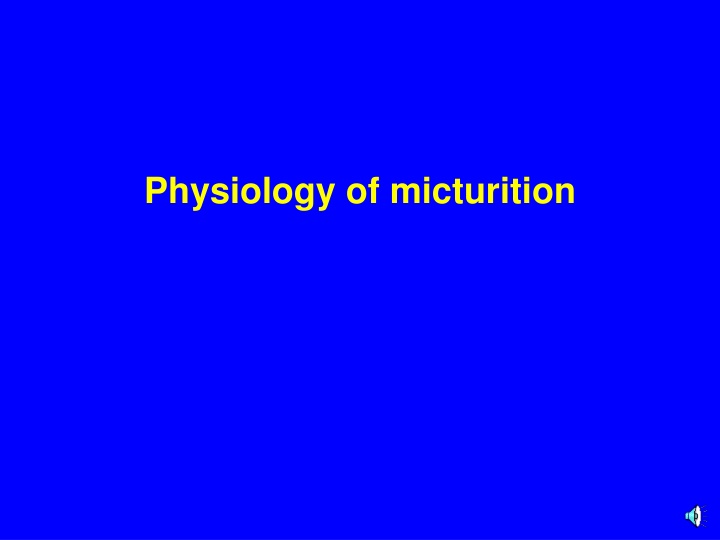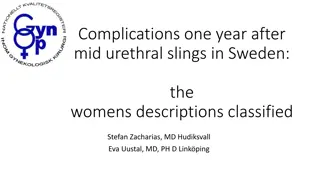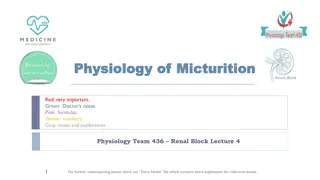
Physiology of Micturition
Explore the functional anatomy and mechanism of filling and emptying the urinary bladder, including the role of detrusor muscles and sphincters. Learn about neurogenic control in micturition and its disorders.
Download Presentation

Please find below an Image/Link to download the presentation.
The content on the website is provided AS IS for your information and personal use only. It may not be sold, licensed, or shared on other websites without obtaining consent from the author. If you encounter any issues during the download, it is possible that the publisher has removed the file from their server.
You are allowed to download the files provided on this website for personal or commercial use, subject to the condition that they are used lawfully. All files are the property of their respective owners.
The content on the website is provided AS IS for your information and personal use only. It may not be sold, licensed, or shared on other websites without obtaining consent from the author.
E N D
Presentation Transcript
Learning Objectives: Identify and describe the Functional Anatomy of Urinary Bladder Describe the mechanism of filling and emptying of the urinary bladder Cystometrogram Appreciate neurogenic control of the mechanism of micturition and its disorders. 2
Urinary Bladder Anatomical consideration: Body: Wall of bladder contain smooth muscle in different arrangement (detrusor muscle), contraction emptying of bladder during micturition. Neck 2 sphincters: -internal urethral sphincters (IUS) in either side of urethra, made of smooth muscle. -External urethral sphincter (EUS), made of skeletal muscle.
Detrusor smooth muscle of the bladder wall Trigone smooth muscle at bladder base Internal sphincter smooth muscle at the bladder neck External urethral sphincter skeletal muscle
Nerve Supply to the Bladder A.Sympathetic nerve (Hypogastric n) B. Pelvic nerve (Parasympathetic) C. Pudendal nerve (Somatic N) 7
INNERVATION OF THE BLADDER Nerves Characteristic Function Contraction of bladder The sensory fibers detect the degree of stretch in the bladder wall Pelvic nerves (parasympathetic fibers) S-2 and S-3 Pudendal Nerve Both sensory and motor nerve fibers 1 somatic nerve Fibers that innervate and control the voluntary skeletal muscle of the sphincter Stimulate mainly the blood vessels and have little to do with bladder contraction. Sensory nerve fibers of the sympathetic nerves also mediate the sensation of fullness and pain. 2 Hypogastric Nerves sympathetic innervation (L2) 3
Autonomic Innervations of the bladder Parasympathetic Supply Sympathetic Supply Nerve Efferents: Origin: Supply: Pelvic nerve Hypogastric Nerve -LHCs of the S 2,3, and 4. -Body and neck of the bladder. a) Contraction of bladder wall. b) Relaxation of the bladder neck stimulation of the detrusor ms of the body causes longitudinal layers to open the bladder neck. a) Carry input from stretch receptors in the bladder neck.. b) Detect bladder fullness. c) Carry pain and temperature sensation. - L1,2, and 3. - Bladder neck. a) Contraction of bladder neck, specially the middle layer facilitate the storage of urine. b) Relaxation of the bladder wall. a) Transmit pain sensation b) Detect bladder fullness Functions Afferents: Sympathetic supply to the bladder cause storage of urine. Parasympathetic supply leads to the Passage of urine.
Somatic Innervations of the bladder The Pudendal nerves (AHCs of S 2,3,and 4) Its efferent fibers arise as the parasympathetic nerves from the 2nd, 3rd and 4th sacral segments of the spinal cord but from the AHCs. They supply and control the activity of the external urethral sphincter
Micturition Definition: Micturition is the process of emptying the urinary bladder through the urethra . Filling of bladder. Micturition reflex. Voluntary control.
Micturition Reflex Two processes are involved: (1)The bladder fills progressively until the tension in its wall is above a threshold level, and then (2)A nervous reflex called the micturition reflex occurs that empties the bladder at 150-200mls of urine volume The micturition reflex is an autonomic spinal cord reflex: however, it can be inhibited or facilitated by centers in the brainstem and cerebral cortex.
Micturition Reflexes Center: sacral segments 2, 3 & 4. Receptors: stretch (receptor) in the wall of bladder. Afferent & efferent: pelvic nerve. Response: 1. Contraction of detrusor muscle (body). 2. Relaxation of internal sphincter of urethra. 3. Relaxation of external urethral sphincter via the pudendal nerve which is somatic nerve originating from AHC of sacral segment 2, 3, & 4.
Stretch receptors Center S2,3,4, IVP Contraction of wall Afferents Pelvic Nerve Relaxation of int. sphincter Efferent Pelvic Nerve Relaxation of ext. sphincter
Cystometry Study the relationship between intravesical volume and pressure. Done by inserting catheter and emptying the bladder, then recording the pressure while bladder filled at 50ml increment of water. This plot is known as the cystometrogram.
Cystometrogram (centimeters of water) Intravesical pressure Micturition contractions lb la Volume (milliliters) Guyton 312-313
Plot has 3 components (segments): Ia initial slight rise in pressure when the first increment in volume are produced Ib a long, nearly flat segment as further increments are produced (conscious level to void at about 150mL) II a sudden, sharp rise in pressure as the micturition reflex is triggered (sense of fullness and urge to void at about 400mL)
Laplace Law The flatness of segment Ib is a manifestation of the law of Laplace, which states that the pressure in the spherical viscus equal to twice the wall tension divided the radius. P = 2T / r
Sensations from the U.B at different urine volumes: At a urine volume of 150 300 ml the first urge to void urine. From 300 400 ml sense of fullness of the bladder. From 400 600 ml sense of discomfort. From 600 700 ml sense of pain. Micturition reflexes start to appear at the first stage. They are progressively intensified in the subsequent stages up to stage 4. Micturition reflexes can be voluntarily suppressed. At about 700 ml break point micturition can not be suppressed. 19
Control of Micturition reflex It is a complete autonomic spinal reflex to get urine outside the body, that is facilitated or inhibited by higher brain centers.
Voluntary Control of Micturition
Higher Centers Control Micturition 1) Cerebral cortex: Motor cortex exerts a voluntary control of micturition either stimulation or inhibition. 2) Hypothalamus: There is facilitatory area in the hypothalamus. 3) Midbrain: Inhibition. 4) Pons: facilitation
Mechanism of voluntary control of micturition: Filling of the bladder beyond 300 400 ml causes stretching of sensory stretch receptors. These sensory signals stimulate sacral segment, which is consciously appreciated by higher centers. 23
If the condition is favourable The cortical centers facilitate micturition by discharging signals that leads to: Stimulation of sacral micturition center. Inhibition of pudendal nerves relaxation of external urethral sphincter. Contraction of anterior abdominal muscle & diaphragm to increase intra-abdominal pressure the intra-vesical pressure is increased. This intensifies the micturition reflex. 24
If the conditions are unfavorable The higher centers will inhibit the micturition reflex by: Inhibition of sacral micturition center. Stimulation of pudendal nerves contraction of external urethral sphincter. 25
1) APs generated by stretch receptors 2) reflex arc generates APs that 3) stimulate smooth muscle lining bladder 4) relax internal urethral sphincter (IUS) 5) stretch receptors also send APs to Pons 6) if it is o.k. to urinate APs from Pons excite smooth muscle of bladder and relax IUS relax external urethral sphincter 7) if not o.k. APs from Pons keep external urethral sphincter contracted stretch receptors
Reflex and Voluntary Control of Micturition Reflex Control Voluntary Control Bladder fills Cerebral cortex + Stretch receptors + + Motor neuron to external sphincter Parasympathetic nerve + Bladder External urethral sphincter opens when motor neuron is inhibited Bladder contracts External urethral sphincter remains closed when motor neuron is stimulated Internal urethral sphincter mechanically opens when bladder contracts Urination No urination
Disturbances of micturition
Micturition reflex stretch receptors
Disturbances of micturition Denervation of the afferent supply e.g.in tabes dorsalis (tabetic bladder): Characterized by: Loss of the U.B. sensations & reflex micturition. Some intrinsic responses of the smooth muscle are retained. The bladder becomes distended, thin walled & hypotonic( atonic bladder). There is retention with overflow i.e. dribbling of urine when the bladder becomes over filled. 32
Micturition reflex stretch receptors
Disturbances of micturition Denervation of the afferent & efferent supply e.g. tumour, injury to cauda equina. Characterized by: Reflexes are abolished. Intrinsic responses of the smooth muscles are increased. The bladder is hypertonic. This is due to denervation hypersensitivity because: degradation of acetyl choline by process of reuptake. cholinesterase in the tissue number of cholinergic receptors. This condition is associated with uncontrolled periodic micturition about 25 100 ml at a time 34
Micturition reflex stretch receptors
ABNORMALITIES OF MICTURITION ATONIC BLADDER Sensory nerve fibers from the bladder to the spinal cord are destroyed Crush injury to the sacral region of the spinal cord and tabes dorsalis Bladder fills to capacity and overflows a few drops at a time through the urethra. This is called overflow incontinence. AUTOMATIC BLADDER Spinal Cord Damage Above the Sacral Region resulting in Spinal shock Lesion return of excitability of micturition reflex until typical micturition reflexes returns & then, periodic (but unannounced) bladder emptying occurs which may be controlled by scratching or tickling Feature




